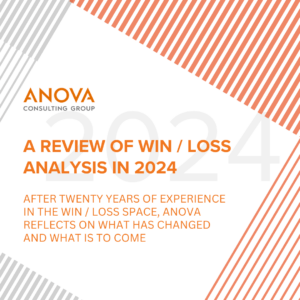
Thursday, May 30, 2024
 This blog was written by Andrew Cloutier, Partner at Anova.
This blog was written by Andrew Cloutier, Partner at Anova.
As Anova celebrates its twentieth birthday this year, we reflect on the evolution of win / loss analysis—a vital tool for understanding buyer behavior and improving sales strategies. Though much about win / loss analysis has remained consistent over Anova’s tenure, many things have also changed, and the pace of change has accelerated over the last few eventful years. Understanding these changes can make the difference in empowering businesses to stay ahead in competitive markets.
This blog series explores the significant changes we’ve seen over the past decade, the enduring principles, and practical tips on how organizations can run an effective win / loss program in 2024.
What Has Changed in Win / Loss Over the Last Decade
While Anova continues to embrace opportunities to educate sales and marketing executives about the value of win / loss analysis, awareness and adoption of win / loss analysis has dramatically increased across industry verticals. Conversations that used to be about why the voice of the buyer is so valuable have transformed into conversations about how organizations can get the most out of voice of the buyer programs.
Today, organizations have access to a much broader range of win / loss solutions—from homegrown programs to automated surveys and hybrid, custom approaches. It is important for buyers to understand the benefits and drawbacks of various options to ensure they pursue the type of program that will provide the most value to their organization.
A notable shift has been the transition of program ownership from sales leaders to product marketing and/or competitive intelligence teams. Though each of these constituencies are consumers of win / loss insights, maintaining connectivity with sales remains essential for program success. Trust and transparency in the process as well as a free flow of timely win / loss contact information are critical components.
Across industry verticals, Anova has found that the lengthening of sales cycle times and the increasing difficulty for B2B buyers to make buying decisions can be attributed to the following factors:
What Has Stayed the Same in Win / Loss Over the Last Decade
While the macroeconomic climate changes, win / loss remains a critical tool in both bullish and bearish market conditions. When budgets are tight and deal flow is down, each sales opportunity increases in importance, and having an in-depth understanding of buyer perceptions can provide the edge that makes the difference between a loss and a win. Conversely, when budgets are free-flowing and sales are booming, win / loss analysis can provide a key source of best practices and sales training materials for expanding teams. It also serves as a rich source of up-to-date competitive intelligence for both established competitors and new market entrants.
The computing adage “garbage in, garbage out” continues to apply to win / loss analysis. In a win / loss program, a primary source of program inputs is CRM data. Incomplete or inaccurate CRM data is a shaky foundation for an insightful win / loss program. This challenge becomes magnified in solutions that prioritize automation without including proper checks and balances to ensure data quality.
An effective win / loss program is not just a tool for understanding past sales outcomes but a strategic asset that can drive future success. Through the pursuit of continuous improvement, organizations can unlock valuable insights that lead to improved decision-making, competitive advantage, and sustainable growth.